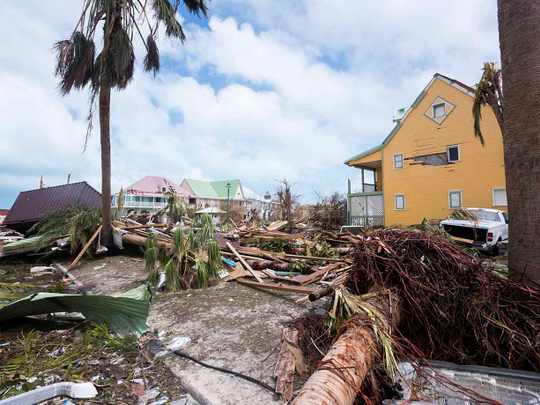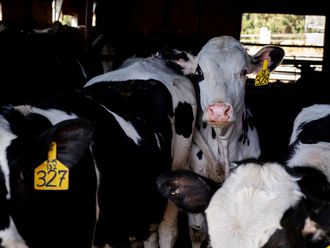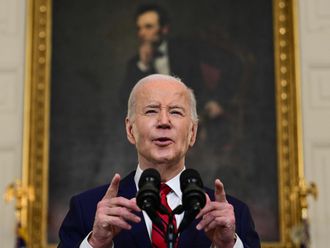
CAP-HAOTIEN, Haiti: Hurricane Irma ripped through the Caribbean on Friday, leaving a trail of devastation and killing 17 as it barrelled towards the United States where up to a million people have been told to flee.
So far, 1.2 million people have been affected by Irma, the Red Cross said.
But that number looks set to rise — and could reach as high as 26 million, the agency said.
Mass evacuation
Up to a million people were ordered to leave coastal areas of Florida and neighbouring Georgia — the biggest mass evacuation in the US in a dozen years.
“It will be truly devastating,” warned the head of the US Federal Emergency Management Agency (FEMA), Brock Long. “The entire southeastern United States better wake up and pay attention.”
Barrelling across the Caribbean, the rare Category five hurricane wielded monster winds and torrential rain, wreaking destruction on tiny islands like St Martin, where 60 percent of homes were wrecked.
“It looks as if an enormous lawnmower descended from the sky and drove over the island,” witness Marilou Rohan told NOS public broadcaster.
“Houses have been flattened. People are helpless, you can see it in their eyes,” Rohan added, saying desperate people were looting supermarkets.
In its westward rampage, Irma packed winds of up to 295 kilometres per hour, an intensity that it sustained for 33 hours — the longest of any storm since satellite monitoring began in the 1970s.
Devastation was left in the storm’s wake. The international Red Cross said 1.2 million people had already been hit by Irma, a number that could rise to 26 million.
Tossed aside like matchsticks
On many islands, roofs were ripped off buildings as if by a giant’s hand, shipping containers were tossed aside like matchsticks and debris flung far and wide, and airports, sea ports and mobile phone networks were knocked out.
St Martin, a pristine island resort divided between France and the Netherlands, suffered the full fury of the storm.
France said four had died and 50 were injured, two of them seriously. Sixty percent of homes were so damaged that they were uninhabitable.
The Netherlands said the storm killed at least one person was killed and injured several others on the Dutch part of St Martin, where communications were all but cut off.
French Prime Minister Edouard Philippe described the disaster as “unimaginable and unprecedented.”
“The work will be long, emotions will run deep and the sadness will be great,” he said.
Food and water
The Netherlands said it was racing to provide food and water for 40,000 people over the next five days, while France said more than 100,000 packages of combat rations were en route.
A 200-member French team flew in to Guadeloupe to coordinate rescue efforts, headed by Overseas Territories Minister Annick Girardin.
Britain said it was sending two warships to help victims in the Caribbean, and earmarking £32 million (Dh154 million) in aid. The first vessel was expected to reach affected territories on Thursday.
‘Everything is destroyed’
Speaking to Dutch broadcaster RTL, Koen, a 20-year-old who lives in the town of Voorhout of St Martin, said he was shocked by what he saw.
“There is huge damage. Sand has been blown over everything. Everything is destroyed.”
Irma also laid waste to Barbuda which suffered “absolute devastation” with up to 30 percent of properties demolished, Prime Minister Gaston Browne said.
“Barbuda now is literally rubble,” he said.
“These storms are more ferocious, they are coming in greater frequency — evidence that climate change is real,” Browne added in an interview with CNN.
More than half of Puerto Rico’s population of three million was without power, with rivers breaking their banks in the centre and north of the island where Governor Ricardo Rossello activated the National Guard and opened storm shelters sufficient for up to 62,000 people.
Fearful course
Irma was expected to hit the northern edges of the Dominican Republic and Haiti later Thursday, continuing past eastern Cuba before veering north towards Florida.
Cuba moved 10,000 foreign tourists, many of them Canadians, away from beach resorts in the exposed part of the island, and hiked its disaster alert level to maximum.
US President Donald Trump has already declared a state of emergency for Puerto Rico, the US Virgin Islands and Florida, and the southern US state of Georgia ordered the mandatory evacuation of the city of Savannah and other coastal areas.
The Sunshine State is expecting to face the brunt of the storm from Friday night, with forecasters warning of sea-level surges of up to eight metres above normal tide levels.
Tourists in the popular Key West islands were packing their bags on a mandatory evacuation order, with a similar order for residents due to follow.
Trump said he was “very concerned” about Irma, but “we think we are as well prepared as we could possibly be.”
“Florida is as well prepared as you can be for something like this, now it’s just a question of what happens,” he said in the Oval Office.
2 more storms: Jose and Katia
Irma hit the Caribbean even as two other tropical storms, Jose in the Atlantic Ocean and Katia in the Gulf of Mexico, were upgraded to hurricane status.
But the French weather service said Jose, now a Category 3 storm, was likely to bypass land, though it could still dump huge amounts of rain that would complicate rescue and recovery operations.
As for Katia, still a Category 1 storm, it is expected to hit the coast of the Mexican state of Veracruz before Friday.
Death and destruction
At least two people were killed in Puerto Rico, and more than half of its three million residents were without power after rivers broke their banks in the center and north of the island.
Another four people were killed on the US Virgin Islands, with the governor's office saying a number of badly injured people had been airlifted to Puerto Rico.
One person died in tiny Barbuda which also suffered "absolute devastation," with 300 people evacuated to Antigua and up to 30 percent of properties demolished.
St Martin, a pristine island resort divided between France and the Netherlands, also suffered the full fury of the storm, as did the French island of St Barthelemy.
France said at least nine people had been killed across its Caribbean territories and seven more were missing.
There were 112 people injured, including two seriously, said Interior Minister Gerard Collomb.
Six out of 10 homes were left uninhabitable, with insurers in Paris estimating their overall costs would likely be "much higher" than 200 million euros ($240 million).
On the Dutch side of St Martin, one person died, officials said. Dutch King Willem-Alexander will head to the island of Curacao to the south on Sunday for a briefing on the aid operation, and may travel on to St Martin, officials said.
"It's as if a bomb went off. Before everything was so beautiful and green here. Now everything is as grey as a Dutch winter," retired police officer Klaas Groen told Dutch newspaper Algemeen Dagblad.
A state of emergency has been declared in the British Virgin Islands where residents spoke of scenes of "total devastation".
"Our downstairs doors suddenly blew out, which was terrifying," Emily Killhoury told the BBC from her home in Tortola.
"We eventually emerged at about 7:00 pm to see total devastation."Britain's defence ministry said it was sending two military transport planes to the region carrying personnel, supplies and recovery equipment.
'Looting'
As European nations quickly mobilized to help their citizens in the Caribbean, French and Dutch ministers said they were sending hundreds of extra police to St Martin tackle a spate of "looting".
The storm has caused major shortages of food, water and petrol.
"The situation is serious," Dutch Prime Minister Mark Rutte said Friday when asked about reports of looting on the island.
Speaking to Algemeen Dagblad, one witness reported seeing "people with guns and machetes" in the street.
French Overseas Territories Minister Annick Girardin said 400 police officers would be deployed after seeing "pillaging right in front of us" in St Martin where most of the 80,000 inhabitants have lost their homes.
In the Dominican Republic, torrential rain and powerful winds whipped the northern and eastern coasts, leaving 17 districts cut off.
Nearly 20,000 people were evacuated and more than 100 houses destroyed.
And in Cuba, some 10,000 foreign tourists were evacuated from beach resorts as authorities hiked the disaster alert level to maximum.
'Walking the plank'
As of early Friday, the eye of the storm was just north of Great Inagua, at the southern tip of the Bahamas.
The worst of the storm is expected to hit Florida Keys and the southern Florida Peninsula on Sunday, the NHC said, with forecasters warning of storm surges of up to 25 feet (almost eight meters) above normal tide levels.
After going for a walk along the beach in Miami, theology professor James Nickolos, 69, spoke of a sense of impending doom.
"I had the feeling of watching a great beauty walking on a gang-plank to their death," he said.
Trump said he was "very concerned" about the situation but insisted Florida was "well prepared" for the storm.
Katia is expected to hit the coast of the Mexico on Friday, while Jose — a Category Three storm — is following Irma's path, the NHC said.
Still reeling from Irma, many islanders were bracing for the next storm, with Jose bearing down hard.
"I hear we could take another direct hit," Carlos Suarez Menendez told Dutch television RTL from Philipsburg on St Martin. "That will be terrible."












